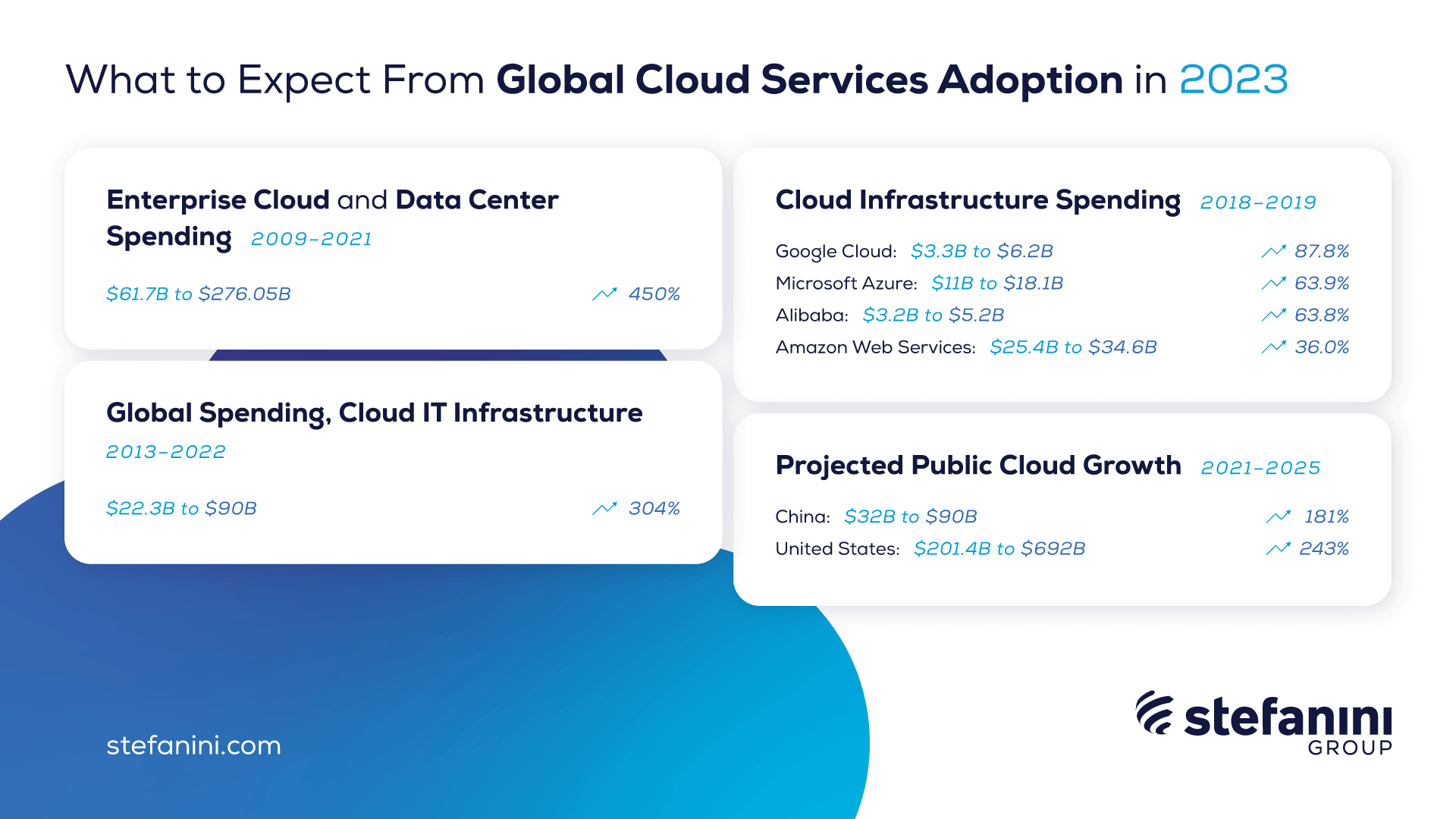- Notable Cloud Statistics
- Evolution of Adoption of Cloud Services
- Growth in Spending on Cloud Services of Global Companies
- Training and Security Advancements to Further Spur Cloud Adoption
- Finance Could Lead Industries Embracing Cloud in 2023
- Global Market Outlook in 2023
- Where We Are Now

For several years, “digital transformation” has been ubiquitous in every significant industry across the globe. This fact should come as no surprise considering today’s rapid pace of technological change. Technological advancements are only accelerating and keeping up with them requires an agile approach that scales across organizations of every size.
That’s why cloud enablement, the process of analyzing and optimizing an organization’s existing IT landscape, is a foundational aspect of any digital framework. Cloud services adoption has been rising dramatically for several years. Just look at the statistics:
Notable Cloud Statistics
450% increase
Enterprise spending on cloud and data centers exploded from $61.7 Billion in 2009 to $276.05 in 2021, a nearly 450% increase.
94%
of tech industry professionals had adopted some type of cloud platform within their organizations as of 2019
80%
of enterprise IT professionals worldwide had deployed a hybrid cloud in their organization as of March 2022
The worldwide public cloud computing market, encompassing business processes, platform, infrastructure, software, management, security, and advertising services delivered by public cloud services, is estimated at $495 billion U.S. dollars in 2022.
In a competitive global marketplace, tech must provide real, tangible results, and that’s exactly what companies that retire legacy applications and outdated data centers in favor of a cloud structure are seeing.
“The cloud has a positive effect on firms’ performance“ says Wang Jin of the Digital Economy Lab at Stanford University. “The effect is statistically significant and economically large, and it grows over time.”
Since the adoption of cloud computing over a decade ago, we’ve quickly seen just how impactful and cost effective cloud services can be.
One survey found that cloud computing improved profits by an average of 22%, while savings on infrastructure boosted cost savings by an average of 23%.
Yet, adoption of cloud based computing services is about much more than cutting costs. In the years to come, we’re going to see a dramatic evolution in how business and technology interact. The organizations that neglect to make the necessary advancements today will be left behind tomorrow.
Evolution of Global Adoption of Cloud Services
In 1997, long before most people owned a PC, Prof. Ramnath Chellapa introduced the term “Cloud Computing” in Dallas, Texas. Shortly thereafter, in 1999, Salesforce.com originated the concept of enterprise applications through simple websites, as well as innovating new ways to help experts deliver applications online.
However, it was arguably in 2006 that cloud services as we know them originated. That year, Amazon introduced their pay-as-you-go cloud services model, a model that has become the standard for cloud services today.
By 2009, the concept of “cloud computing had very much arrived, with Salesforce becoming the first cloud computing company to reach a valuation of over $1 billion. And in 2013, with the introduction of Infrastructure as a Service (IaaS), the Worldwide Public Cloud Services Market became the fastest growing market service of the year.
Growth in Spending on Cloud Services of Global Companies
Over the past decade, spending on cloud services has been on a remarkable rise. From 2013 to 2022, annual spending on cloud IT infrastructure worldwide from 2013 to 2022 rose from $22.3 billion to $90 billion, with large global enterprises including Dell Technologies, HPE, Inspur, Lenovo, IBM, and Huawei leading the market. And the trend is only increasing.
From 2018 to 2019, Google Cloud increased their worldwide cloud infrastructure spending by 87.8%, from $3.3 to $6.2 billion. During the same period, Microsoft Azure and Alibaba Cloud each increased their spend by nearly 64%, while Amazon Web Services increased their global spend by 36%.
Of course, the global marketplace experienced a dramatic shock with the Covid-19 pandemic the following year. Yet, this fundamental shift did nothing to deter the growth of cloud investment,
On the contrary, global spending on cloud infrastructure in Q3 of 2020 was up 33% over 2019, including a 29% increase for Amazon Web Services and a 31% increase for Microsoft Azure.
With multibillion dollar spends on cloud infrastructure at the largest companies in the world, you could be forgiven for believing the cloud computing revolution has already passed us by. Yet, in many ways the cloud computing industry is still in its nascency.
In the Eurozone, only 42% of EU enterprises was using cloud computing as of 2021, a six percent increase year-over-year. And parsing the data reveals some even more striking facts. While rates of cloud use in Sweden and Finland (both at 75%) and the Netherlands and Denmark (both at 65%) are both quite high, rates of use in young tech hubs like Romania are still low – only 13% as of 2021, suggesting a large runway for cloud growth in the coming years.
Training and Security Advancements to Further Cloud Adoption
Of course, adopting the cloud requires more than the desire to embrace cloud technology. While leaders of businesses of all sizes are look to reduce cost and raise efficiency by migrating to the cloud, many industry leaders have found themselves running up against a significant obstacle: a lack of qualified talent with necessary cloud skills.
In fact, as of 2020, over 80% of cloud leaders pointed to a lack of internal skills and knowledge as the top barrier to successful cloud deployment. Perhaps the clearest sign of just how fundamental the shift to cloud has been, 87% of hiring managers said they “value hands-on experience and certifications” for cloud-related skills among job candidates even more than a university degree.
Also hindering cloud adoption is concern over cybersecurity threats. While a properly secured cloud platform is not at greater risk than legacy methods of data storage, the perception of risk is still a hurdle.
“It is clearly not true that cloud is always less secure,” says Andi Mann, VP of Strategic Solutions in the Office of the CTO at CA Technologies, “but there is enough truth in this to turn off many IT and even business decision makers, especially for mission-critical or commercially-sensitive systems and data.”

Download our FREE guide on how to choose the right cloud provider for your financial institution. You’ll find out what questions to ask when selecting a cloud provider.
Finance Could Lead Industries Embracing Cloud in 2023
Thus, considering their need for unassailable confidence in security, it should come as no surprise that financial services companies currently are among the biggest laggards to deploying cloud as a central part of IT operations.
Despite relative reluctance to fully embrace cloud computing in finance, many signs point to the financial sector coming around to cloud adoption. Even leaders at organizations that have been slow to adopt agree that cloud technology has many benefits, while approximately 70% of industry leaders say they are in the trial and testing stage of cloud adoption.
Just as we’ve seen since the late 2000’s, 2023 is expected to be another year of dramatic growth for transition to the cloud.
53%
of organizations believe that at least half of their applications and workloads will reside in the public cloud by 2023.
34%
of organizations claim that at least half of their applications and workloads reside in public cloud infrastructure today
Cybersecurity spending and building resilience against data loss, and addressing post-pandemic disruption to global business are all expected to be major concerns in 2023, as well as a push toward artificial intelligence and machine learning integration in cloud services.
Large scale cloud platforms like Amazon Web Services and Microsoft Azure have been promoting their respective A.I. and M.L. technology platforms as effective strategies for raising efficiency and lowering costs. With growing threats of widescale economic recession likely to impact nearly every industry in 2021, expect to see a focus on A.I. and M.L. as forward-thinking solutions to economic challenges.
Global Market Outlook in 2023
Another trend that should quicken in the near term is the growth of cloud infrastructure in China. Despite slow adoption relative to the US and much of Europe, China has made rapid strides toward cloud investment in recent years. Since 2022, China has held the world’s second-largest market after the US, and China’s public cloud is expected to grow from $32 billion in 2021 to $90 billion by 2025.
The coming year could also be the year that businesses come to understand the advantages of diversifying their services across various cloud providers. One report found that 84% of mid-to-large companies will have adopted a multi-cloud strategy by 2023. This multi-cloud strategy offers a number of advantages, including improved flexibility and security. It could be the next phase in a cloud computing market that’s could reach $623.3 billion in 2023.
Of course, use of multiple cloud platforms can create even more complexity and potential points of failure. To better handle the difficulties of multi-cloud implementation, a growing number of companies are expected to seek outside services.
Finding the right partner for cloud implementation brings its own set of challenges. Even the most innovative cloud enablement and implementation strategy is only as effective as the people supplying the services. Trust is essential when seeking to partner with an outside organization, as well as a proven track record of expertise and effective communication. That’s why so many companies looking to elevate their cloud computing strategy choose to partner with Stefanini Group.
Where We Are Now: Position of Stefanini Group in Cloud Adoption
As a global leader in technology innovation, Stefanini Group was an early adopter of some of the most advanced and useful cloud computing capabilities. Over the years, Stefanini has earned a reputation as an agile company that’s committed to building strong relationships with the companies we partner with. That’s precisely the quality of service our clients receive when they come to us for cloud enablement and related digital services.
Stefanini Group has been an effective data provider, data strategist and evolution partner for clients looking to create an effective cloud environment since 2017.
Today, Stefanini Group services include implementing and optimizing processes, collecting data and providing strategic provocation for problem solving. We’re proud to provide a center of excellence with a generation’s worth of insights.
Stefanini is renowned for taking a customer-first approach to everything we do. We analyze the unique situation of your business, and work with you to co-create customized solutions that are optimized for your business. Our team is equipped to work with our clients for cloud adoption and optimization needs such as IaaS, PaaS, SaaS, and much more.
From strategy to migration, architecture and native development to governance service management, Stefanini is capable of building a unique cloud adoption and optimization journey for your company. Give us a call to speak with an expert!
Learn more about cloud services of Stefanini.




















